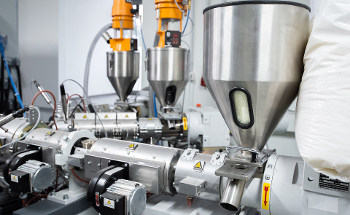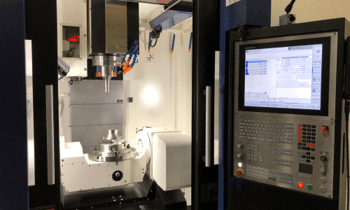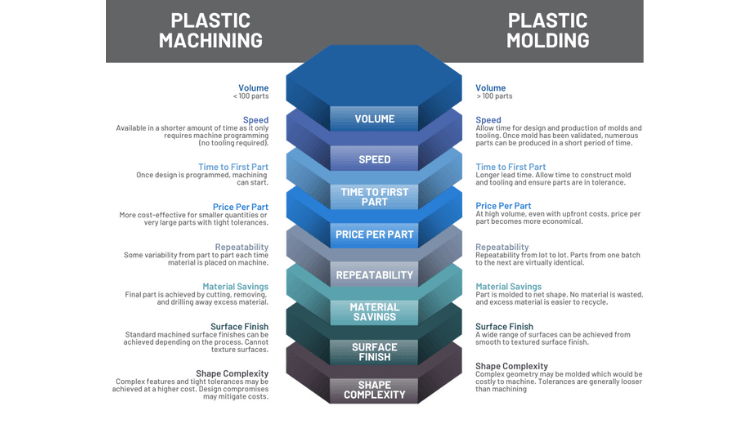
Plastic Machining vs. Plastic Molding
Posted by CDI Products on Oct 05, 2022
What are the Top 8 Things to Consider?
We routinely partner with customers who are debating whether to use machining or molding to fabricate their custom plastic parts. Molding and machining of plastics are both trusted production processes, but how do you know which is best for your components? Before prototyping your component, it is critical to analyze your options, such as material selection and the pace and volume of part production, and then decide which strategy works best for your requirements. It's a complex decision that can be answered by weighing eight distinct factors. Before we address the 8 things to consider, let’s define the difference between machining and molding of plastics.
What is Plastic Molding?
In the plastic molding process, solid polymer pellets - which are rigid when cool but viscous at higher temperatures - are heated to their melting point and injected into a cavity known as a mold – they are also known as tools. The pellets then cool in the mold's form and once completed, the mold is opened, and the part is ejected.
Types of Plastic Molding Methods
- Injection Molding: This process is highly prevalent in the plastic industry and is well-suited for manufacturing a wide variety of plastic parts, including seals. It offers high precision, which is vital for manufacturing seals that need to conform to exact dimensions to function effectively. Different plastics, including thermoplastics and some thermosetting plastics, can be used in this process.
- Compression Molding: This method is also compatible with a range of plastics, particularly thermosetting plastics. In compression molding, the plastic material (usually preheated) is placed in an open, heated mold cavity. The mold is closed with a top force or plug member, pressure is applied to force the material into contact with all mold areas, while heat and pressure are maintained until the molding material has cured. It's quite effective for creating robust and durable seals and components, especially when using high-strength plastics.
- Transfer Molding: Similar to compression molding, transfer molding is an ideal choice for forming high-strength parts. The process involves pushing the plastic material through a heated chamber into the mold where the material solidifies. It allows for the manufacturing of more complex parts compared to compression molding, and a wider variety of plastics can be used, including both thermosetting and thermoplastic polymers.
What is Plastic Machining?
Precision plastic machining is a complex process that involves using sophisticated equipment to cut away extra material from a larger block of a solid material until the final output is the correct form and size. Secondary machining operations on plastic components may be necessary to provide tighter tolerances than what a molded process can offer.
Types of Plastic Machining Methods
- CNC Milling: Particularly used for complex seals with intricate features or profiles. This method allows for high precision and is suitable for a variety of polymers.
- CNC Turning (Lathe): This can achieve tight tolerances and work with a range of polymer materials.
- Drilling: As a manufacturer, this method is often used with other machining processes.
- Grinding: Grinding is a process completed in post-production. It can be used to achieve the desired finish and exact dimensions, especially if high precision is required for the product application.
- Polishing: The polishing process creates a smooth surface finish, which can be critical depending on the seal or components environment and minimizing wear over time.
What are the Top 8 Things to Consider?
Now that you better understand the differences between the processes, here are the top 8 things to consider in the debate on machining versus molding.
- Volume
- Speed
- Time to First Part
- Price Per Part
- Repeatability
- Material Savings
- Surface Finish
- Shape Complexity
The infographic below is a great starting point when deciding which method to use. In the infographic, we go into greater detail about the specific considerations and provide some helpful tips in the decision-making process.

CDI Experts
Here at CDI, we think that having more knowledge is always better when it comes to choosing the optimum production procedure for your plastic parts. Interested in learning more about your machining versus molding options for plastics? We also offer machining and molding for rubber which are distinct processes from plastic production. Whether it’s plastics or rubber components, we are here to help. Our experts in custom design, material science, machining, molding, tooling, and parts production are able to assist you at any stage of the process, from prototype design through mold manufacturing to domestic and international parts production.
Topic: CNC Machining, injection molding, molding, plastic injection molding, rubber injection molding